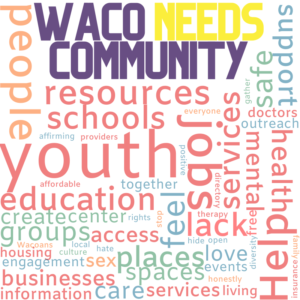By Becca Muncy
Whether you’re looking for something spooky, something cozy, something family-friendly, something crafty, or something relaxing, you’re sure to find something fun to do this fall! Click the links to find out more information about each event.
First up, everyone’s favorite October holiday: Halloween! There’s no shortage of spooky, scary events going on in Waco right now:
- October 23- Pumpkin Decorating Contest, hosted by Waco Parks and Rec. Submit your decorated pumpkin by October 23 and vote on the best pumpkin until October 30. Winners will be announced on October 30!
- October 23- Halloween Make & Take Workshop at Board and Brush. Create a fun piece of Halloween decor! All materials are provided. There are two afternoon workshop sessions; sign up for the 1:00 session here and the 1:30 session here. Cost is $15.
- October 24- Monsters of Waco Escape Game, hosted by Waco Escape Rooms. Grab your team and get ready to race against the clock and other teams as you solve puzzles around Waco! Your mission: to find the mysterious Monster 11 and solve the mystery of Scary O’Ghouligan. Tickets are $31.
- October 25- Skellington Curiosities’ October Market. Enjoy goods from 30 local vendors and artists, as well as a costume contest. You’re sure to find something spooky at this market!
- October 25- Sensory Friendly Treats-to-Trunk from Elite Therapy Center. Vendors bring the treats to you at this drive-thru reverse trunk or treat for kids with special needs and disabilities!
- October 28- Howl-O-Ween Party with Best Fido Friends. Enter your pup in a costume contest and get a goodie bag!
- October 29-31- Scared Sober Haunted House, hosted by Sunshine Recovery House. Tickets are $5 and all proceeds fund the work of Sunshine Recovery House. Learn more about this event and Sunshine Recovery House from this Act Locally blog post!
- October 30- Halloween Masquerade Late Skate at Skate World Waco. Skate until late, join in on a laser tag tournament, and enter a costume contest! Get tickets here.
- October 30 and 31- Halloween DIY Fun with The Rustic Brush. Pick up your kit (all materials included) and have some Halloween crafting fun at home! Kits cost $20. Reserve your kits here.
- October 31- Free Halloween Skate at Skate World Waco. Come in costume and skate for free!
- October 31- Drive-Thru Trunk or Treat at Holy Spirit Episcopal Church. Trick or treat from the safety of your car!
- October 31- Trunk or Treat + Fall Festival at BridgeChurch
If spooky Halloween activities aren’t your cup of tea, or if you’re just looking to continue the fall fun into November, check out these other fall-themed events:
- October 23-31- Blow-Your-Own Pumpkin Event at Stanton Studios. Make your own unique glass-blown pumpkin! Workshops take place October 23, 24, 30, and 31. Cost is $48.
- October 24- Succulent Pumpkin Workshop & Beer Tasting, hosted by The Plantery and Southern Roots Brewing Co. Enjoy Waco’s best craft brews and create a beautiful succulent pumpkin arrangement!
- October 24- Autumn Uptown Art Walk with The Kieran-Sistrunk Art Gallery and MC Art Supplies. Take a stroll down Washington Avenue and help support Waco artists and musicians!
- November 6-7- LuluBelle’s & Cedar Chest Outdoor Fall Market at Cedar Chest Antique Mall. Visit over 150 vendors at this outdoor fall market, all weekend!
- November 21- Virtual Central Texas Turkey Trot. This year, the 15th annual Turkey Trot has gone virtual! Register by November 20 and log your run anytime from November 21-30. Cost is $40.
- November 27-29- Homestead Fair. Join the Homestead Heritage for a weekend of shopping, crafts, activities, agricultural exhibits, and great food! Check out the schedule of events here.
And, finally, if you’re looking for a way to give back this season, be sure to check out these opportunities:
- The Coats N’ Cocoa Coat Drive, hosted by The New Black Collective. To donate a coat, email [email protected]
- Mentor Waco’s 2nd Annual Friendsgiving Lunch, with Mentor Waco. Donate items now through November 12. See what items are needed here.
This is the round up so far, but we are learning about new events and opportunities for fall fun every day, so keep an eye on the Act Locally Waco Events Calendar.

Becca Muncy is an Act Locally intern from Dallas. She is studying professional writing at Baylor University and is completing her senior year.
The Act Locally Waco blog publishes posts with a connection to these aspirations for Waco. If you are interested in writing for the Act Locally Waco Blog, please email [email protected]for more information.
By Trent Sanders
(You can learn more about “Epiphanies” a new works festival being staged by Wild Imaginings, in Trent Sutton’s blog post from last week. – ALW)
I first heard about Trent and his theatre company, Wild Imaginings, in a funny sort of way. Luann Jennings, founding artist of InSite theatre company in Waco, had invited me to co-direct a show. I accepted, and her welcome to me went, “You’re Trent 2.0.” I thought, “Like Tosh?” To say the least, this name intrigued me. Trent Sutton had directed shows in Waco for a number of years and had recently formed his own company. I wondered under what circumstances I would meet Trent 1.0. All this took place in early 2020, before the shutdowns.
Eighteen months earlier, in October 2018, my wife, three-month old son, and I had moved to Romania. The U.S. Bureau of Educational and Cultural Affairs had awarded me a Fulbright Creative Arts and Performance grant. My stated purpose was to study and write a play about Romanian Christian exiles fleeing the threat of the Romanian Communist Party. Ironically, a year later, in September 2019, I learned that many of these people had moved to the U.S. Some of you may have heard of Lucy Lupu. She and her husband, Petru, have a harrowing story of escape by night. Yet, for my purposes, a different and significant batch of Romanians were still living in Romania.
I told Trent 1.0 all this after the last performance of InSite’s Shakespeare mashup, “Law and Order.” He was kind enough to listen with enthusiasm, then asked me what I did instead. Enter Camelia.

The play is her namesake and her song. She sings of her family, their flight from murderers coming from the East, their saga as refugees, and their multi-generational fight against a broken system. She sings of Romania. Camelia Doru was born in Călimănești – a small village in the Transylvanian Alps. There, she spent her formative years listening to the conversations of many, now famous, Romanian literary dissidents, who were sent there, on the Romanian Communist Party’s dime, to write propaganda (though they never did). She sets out on a journey, armed with her wit against the darkness, to redeem her own history, and by extension, Romania’s.
Trent 1.0 did that sort of frown you do when you hear something you like but have nothing else to add. I said one more thing.
While interviewing Camelia, she mentioned a summit she had attended in 1991. She went on to say the Rockefeller Foundation had summoned the world’s leading torture experts there. He was caught off guard – there are torture experts? Yep. I continued. They met in order to create a tactical map to end torture. Over the course of a week, they mapped out the terrible constellation of torture. Amazed, I asked her if she had a copy. She then rolled out a 100 square foot map. At the center of this nearly invisible universe is the torturer and the victim.
This might sound thought out, but the play was in rough shape when I first showed it to Trent 1.0. He and I both agreed that, in its current form, it had no place in Waco, likely not in Texas, and just a sliver of a chance in the U.S. It was too symbolic. Romanians love that sort of thing, but not so much the Americans.
He prompted me to form it around a question, then to rewrite it according to the question. After that, the play returned to some semblance of its roots. It had begun as an oral history – with me sitting down in Camelia’s office in Bucharest. Asking her questions. Listening. Later on, transcribing. After some thought, I began to ask two big questions: Is her story about how to redeem history? – At least, a kind of redemption in continuum? Is religion somehow involved?
In any case, he asked me to submit the play for his company’s festival, so I did. By April, he informed me that it had been one of eight chosen for a table reading. Fast forward into early May, Trent 1.0 and the actors had done a remarkable job reading and responding to the script. After three hours of this via zoom, I had a great air of confidence for the revisions that lay ahead. And I knew what symbolism to get rid of and how. Camelia’s world, literally closed off to the West until 1989 because of the Iron Curtain, and literarily closed off to the West until June 2020 because of my bad writing – was now readily accessible. I hope it lets you get her. I hope her wit gets you.
But you be the judge on Saturday October 24 at 6:30 PM when Camelia begins streaming. You can purchase a ticket to the festival by clicking here. The cost is $15.
I almost forgot to mention two more things. The problem with faith (and herein lies its power) is that it is incarnational. Culture, place, and era embody it. In Camelia, you will see this conflict: an irreligious woman, encountering godless problems, all while facing God. Is anything out of his purview?
That being so, Camelia loves democracy – the American kind – and I think that shines through. If you love democracy, this is a play for you. If you want to be a part of a conversation about a more perfect union, this play is a great conversation starter.
Peace be with you.

Trent Sanders holds two degrees (B.A. and M.A.) in literature and criticism. After completing his studies, he spent a year studying and making theatre on a Fulbright in Romania. He is currently the playwright in residence at Baylor’s Institute for Oral History.
The Act Locally Waco blog publishes posts with a connection to these aspirations for Waco. If you are interested in writing for the Act Locally Waco Blog, please email [email protected] for more information.

Press Release – Over the past month and a half, Waco Pride Network has gathered input from Waco’s LGBTQ+ community and its allies on what the community’s most pressing needs are, what Waco could be in five years, and what Waco Pride Network can do to pursue that vision. Today, that process reaches its conclusion with the announcement of Vision 2025: Waco Needs Community.
In the vision statement, Waco Pride Network notes, “When we sat down to look at the responses we received, we decided to focus on the words people were using. Three words immediately jumped off the page: Waco needs community. Suddenly, all the needs, fears, and dreams that had been expressed centered themselves around that message. Waco needs community. Waco needs community space. Waco needs community resources. Waco needs community support.”
The vision statement focuses on the words Waco’s queer community and its allies submitted during the public input process. “We need places to be together,” wrote one individual. Waco Pride Network is responding with a commitment to pursue dedicated community spaces in Waco and a vision that these and other safe spaces be available and easily identifiable within five years.
“There’s still a stigma,” writes another individual, “which in turn can and does lead to bullying and being left out. I haven’t noticed it as much here as in the TX Panhandle, but it’s there. Kids are worried about being seen as ‘different’, especially when school is their only real safe haven. Quite a few have problems at home.” The vision highlights the need for community support both within Waco’s queer community and between Waco’s LGBTQ+ folx and Waco in general. “The need here is deeply felt. Our community feels disconnected both from itself and the greater Waco community. We do not see ourselves in business, community, or civic leadership. We do not feel that Waco is for us.”
Ultimately, the statement commits Waco Pride Network to pursuing a Waco with:
- Physical Spaces that are committed to the use of the LGBTQ+ community
- Safe Spaces that are readily available and easily identifiable
- Resources that are identified as accessible and safe
- Regular community engagement through events and a thriving digital community
- The greater Waco community acknowledging the issues faced by the LGBTQ+ community
- An LGBTQ+ community that feels supported by the Waco community, at large
Regarding what you can do, Waco Pride Network has a number of suggestions. “Keep an open mind and engage with the LGBTQ+ people you know,” the statement says. “If you are welcoming and affirming…MAKE it known, hire an LGBTQ+ employee, serve an LGBTQ+ customer, or fund an LGBTQ+ entrepreneur.”
Waco Pride Network works to foster Waco’s LGBTQ+ community. The full vision statement can be found on Waco Pride Network’s website (wacopride.org) and sections of the statement will be shared throughout the day on social media.

Waco Pride Network was officially founded in July 2018 as a nonprofit serving the LGBTQ+ community of the Greater Waco area. Waco Pride Network’s keystone event is the annual OUT on the Brazos festival held each October. The all-volunteer organization continues to grow each year through community support.
Virtual public open house set to take place October 20 – November 3.
Press Release – Over the course of the next several months, Waco Transit System (WTS) and its consultant team will conduct an environmental review pursuant to the National Environmental Policy Act and develop preliminary engineering design plans for the City of Waco’s first Bus Rapid Transit (BRT) corridor.
WTS is developing a 13-mile BRT corridor to provide buses every 15-minutes during peak service hours; including extended service hours to 10 p.m. and service on Sundays to offer safe, reliable and efficient transit service. The route is oriented in a northeast-southwest direction and will serve industrial and commercial employment centers, the Central Business District, as well as important retail centers for residents and visitors; it also connects Waco with the adjacent cities of Woodway, Beverly Hills, Bellmead and Lacy-Lakeview.
In 2018, following the completion of a two-year feasibility study that evaluated the transportation system, travel demand patterns, existing and future land use and input received from the public, Waco Metropolitan Planning Organization (MPO), City of Waco and WTS selected and approved a BRT route that features 14 station locations.
The BRT project has garnered extensive community support and to build further upon that momentum WTS and the Waco MPO look forward to continuing to engage the community throughout the next phase of development.
To help re-engage the community with the BRT project, WTS with the support of the Waco MPO is hosting a virtual public open house that features updated project information available in English and Spanish and an interactive route and station location map. (In light of restrictions on public gatherings, the initial public open house for the BRT project is being offered online, rather than in-person.)
The virtual public open house will remain open through November 3 and can be accessed online at WacoBRTopenhouse.net.
A new BRT project phone line featuring prerecorded messages with a voicemail option for submitting questions and comments is also available. The project phone line number is 844-922-6278 (844-WAC-OBRT).
In the coming months, community members will have an opportunity to review and comment on various BRT corridor amenities and design features; including the station locations and proposed operations scenarios.
To sign-up to receive project-related notices, please email the project at [email protected].
For more information about the Waco BRT project, visit the project website at waco-texas.com/transit/BRT.

By Mary Beth Kauk, Director of Development

Since the pandemic began in March, Caritas of Waco is serving, on average, over 10,000 individuals a month, many of them affected by Covid-19. When you support Caritas, you are supporting people in our local community, like Sabrina and her daughters.
Sabrina is a single mother of four girls. She also supports her mother who is disabled. Sabrina is the only provider in her household. Sabrina was able to support her family by having a stable job as a General Manager at a local restaurant. Then in March of 2020 everything changed. Due to Covid-19, the restaurant had to close and she was laid-off. Sabrina was devastated.
“Going from a stable job with full-time employment and benefits to unemployment was a huge impact on our family,” said Sabrina. “$500 a month on unemployment is not enough to support four children and two adults.”
Because of her job loss due to Covid-19, Sabrina had to decide whether to pay bills or put food on the table. But things got worse. Sabrina was notified that the restaurant would not make it after the closings of Covid-19 and would be shutting its doors permanently. “I felt hopeless. I felt I had nowhere to turn and then my sister recommended calling Caritas.”
Sabrina called and was connected with a Caritas Intensive Case Manager. Caritas was able to help Sabrina and her family by paying their late electricity bill and rent bill. “Caritas helped me when I had nowhere to turn. In addition to the bill assistance, I am also able to get food at Caritas to help feed my family.”
Sabrina is still job searching but has enrolled in school to use her time to further her education. “It is so hard right now. Not many people are hiring, especially for restaurant general managers. I am thankful that my family and I have a place like Caritas to turn to.”
Sabrina is just one of the thousands of people in our community hurting from the effects of the pandemic. Caritas of Waco has served people in our community for over 53 years and continues to serve as place of hope, especially during this time. To make a gift or to get involved, please visit www.caritas-waco.org. Your support is appreciated now, more than ever.
*Thank you, Sabrina, for your willingness to share your story.

Originally from Virginia, Mary Beth Kauk now calls Texas home. She attended the University of Mary Hardin-Baylor where she obtained her bachelor’s degree and Master of Business Administration in Management. Prior to Caritas, Mary Beth worked in development, marketing, and PR for United Way of Waco-McLennan County and United Way of Central Texas. When she is not working, she enjoys being outdoors and spending time with family and friends. Mary Beth is married to Kasey and they have three fur babies – Wally, Kaiser, and Sunshine.
Press Release – The Waco Suspension Bridge will close for a rehabilitation project beginning the week of October 19. A virtual groundbreaking ceremony will air at 10 a.m. Thursday on the City of Waco Facebook page and Waco City Cable Channel (available on Spectrum and Grande and live stream at www.wccc.tv) to commemorate the start of the project and the 150th anniversary of the bridge.
Significant areas of Indian Spring Park and Martin Luther King, Jr. Park will be closed throughout the duration of the project. Portions of the Waco Riverwalk on both sides of the bridge will also be impacted, as well as traffic lanes along University Parks Drive and Martin Luther King, Jr. Boulevard. While areas surrounding the project site will be affected, the river will remain accessible for watercraft and leisure activities.
The project is slated to last 18 to 24 months. Gibson and Associates, of Balch Springs, Texas, submitted a $12.4 million bid proposal and was selected as the contractor. The project includes widescale updates to the foundations, towers, decking and railings.
Constructed in 1870, Waco’s historic Suspension Bridge is recognized as an engineering marvel of its time and a significant landmark. Notably, this bridge also represents one of the first community-driven civic improvement projects. In the 1860s, local residents contributed the initial funding.
This landmark and its surroundings have become the cultural center of Waco’s public gatherings and recreation, hosting large tourism events and intimate gatherings equally well.
Project partners include funding support from the Tax Increment Financing, engineering by Patrick Sparks of Patrick Sparks Engineering, the Texas Historical Commission, the McLennan County Historical Commission and the City of Waco Historic Landmark Preservation Commission.
For project updates, please visit waco-texas.com or contact the Parks and Recreation Office at (254) 750-8080.
By Anna Dunbar
Have you ever participated in a drug take-back program? If not, what do you do with leftover medicines after you are over that awful head-cold or find some expired pain medicine? I was shocked to learn that some folks think it is a good idea to flush unwanted or expired medicine or put them in their trash. When flushed, medicines can end up in our waterways and can ultimately travel to Texas’ coastal ecosystems. It is possible that chemicals in the flushed medicines are now in our waterways. Why is that? Because wastewater treatment plants, where the flushed stuff goes, do not remove chemicals; the plants remove organic waste in human waste. Obviously, flushing unwanted medications is not a good idea when much safer options are available for no cost.
On Saturday, October 24, folks will have an opportunity to safely clear their shelves of expired, unneeded, or unused medications that may pose a public health threat.
What is accepted: Prescriptions/Over-the-counter medications, veterinary medications, vitamins, minerals and drug samples
What is NOT accepted: Oxygen Tanks, Needles or other sharps, Inhalers or thermometers, Nebulizers or IV bags, hydrogen peroxide, liquids
Waco 24-Hour Drop-off location (Starting Friday morning, October 24 and continuing through Sunday, midnight, October 25)
- WACO POLICE DEPARTMENT, 3115 PINE AVENUE
What if you are not available on October 25?
The following locations have installed safe medication disposal kiosks. Individuals can safely and conveniently dispose of their unwanted, unused or expired medications at no cost. Certain items are NOT accepted including needles, inhalers, aerosol cans, hydrogen peroxide, thermometers, and illicit drugs.
Year-round Medication disposal locations in our area:
- BAYLOR SCOTT & WHITE PHARMACY #251, 1412 N. VALLEY MILLS Dr, SUITE 116, WACO
- WALGREEN CO., 4100 BOSQUE BOULEVARD,WACO
- WALGREEN CO., 9101 WOODWAY DRIVE, WOODWAY
- CVS PHARMACY, INC., 820 S 5TH ST., WACO
Thank you for choosing to do the right thing!


Anna Dunbar is the solid waste administrator for the City of Waco Solid Waste Services. She is responsible for informing Waco residents and businesses about recycling and waste reduction opportunities as well as solid waste services in Waco. Her husband is a Baylor professor and her daughter is a Baylor University alum who works at Horizon Environmental Services, Inc. Anna is an active member of Keep Waco Beautiful and The Central Texas Audubon Society.
The Act Locally Waco blog publishes posts with a connection to these aspirations for Waco. If you are interested in writing for the Act Locally Waco Blog, please email [email protected] for more information.

By Trent Sutton
The Epiphanies New Works Festival arose in much the same way that many of the projects at Wild Imaginings do. It started with a discovered desire in the Waco community, a conversation over coffee, and two people dreaming together. I can still remember the Friday morning that I sat in Fabled across the table from Rosalind Jackson-Roe, the Festival’s co-founder. It started as, “Well, what if we…” and by the end of an hour, had turned into “Ok, so here’s what we have to do.”
Since that conversation, a truly remarkable journey has been embarked upon. A process has been created unlike any that I have seen, and the feedback from those involved has been incredible.
We had the privilege of granting 8 of playwrights the opportunity to hear their work read aloud at a table reading, after which they were able to interact with the actors and receive invaluable feedback. They were then given time to revise their work and resubmit it, after which we chose 4 of those 8 to be performed at the festival. Far from solely a performative opportunity, we have designed Epiphanies to be a form of professional development that is often difficult to come by.
Watching these plays come to life before my eyes, seeing playwrights see their dreams dance before their very eyes, and witnessing the progress of ideas as they chase the proverbial sunset—these are the reasons that I do what I do. Epiphanies has encompassed the heart of Wild Imaginings in ways that I could never have foreseen, and that it was formed in the very type of collaborative ‘bring dreams to life’ kind of way that our very organization was built upon makes it that much sweeter.
From the beginning, our mission at Wild Imaginings has been to be a community where creativity reigns. And our mission is shaped accordingly, that we may remain fully committed to 5 key things, that we lovingly refer to as the rules of the reign:
- Creating an affirming community in which local artists are empowered to pursue the development of new and relevant work.
- Valuing the identity and dignity of all persons by creating a safe space for difficult conversations through the art of storytelling.
- Cultivating a willingness to explore, experiment, and otherwise push the boundaries of what performing arts can be and the impact they can have in the community.
- Striving to elevate the role of performing arts in Waco by maintaining their standards of originality, relevance, and artistic excellence.
- Preserving the joy of performance by refusing to let go of childish dreams, fantastic fantasies, and wild imaginings.
Epiphanies, simply put, checks each of these boxes in a remarkable way. You can be certain that it is going to be a part of the lifeblood of Wild Imaginings, an event to which we may look forward to seeing year after year. Because for Wild Imaginings, and certainly for Epiphanies, this is only the beginning.
And who knows what other coffeeshop dreams will happen next?

Trent Sutton is the Founder and Artistic Director of Wild Imaginings, a newly formed performing arts nonprofit here in Waco, TX. He has recently graduated from Truett Seminary with his Master of Divinity, and has already made Waco his home. He is passionate about the arts and believes them to be the best way in which he can contribute to the city which he has grown to love so much. He believes Wild Imaginings is uniquely positioned to truly bring a different flavor of art to Waco, and he is excited for what this new adventure will bring. His desire is that this community be limited only by the scope of their imaginations. His favorite thing is sharing dreams and ideas and working together to bring them to life. So don’t hesitate to reach out!

By Jennifer Tobin, Sunshine Recovery House Board of Directors, Secretary
When my best friend asked me to be on the board of a sober house, I thought, “I don’t know how to be a board member, but I believe in her and that women need a second chance (sometimes 7×70 chances) to get on their feet to learn to maintain a life of sobriety.” So, I jumped in and became one of the founding board members of Sunshine Recovery House. I have been involved with each aspect of gaining our non-profit status, setting up & enforcing house rules, fundraising, and day-to-day operations of our social enterprise UnSHAKEable Milkshakes. Sunshine Recovery House, a 501(c3) nonprofit, is currently one of very few places in Waco that offers safe, affordable, accountable housing for women in the early stages of recovery from drugs and alcohol. Women who move to a sober living home are more likely to remain sober than if they were to return to the environment they left when they went to treatment. These women are someone’s daughter, sister, mother, aunt, niece, and friend who are recovering from the disease of addiction. Sober living homes provide a community foundation to learn how to live life free of addiction.
In August 2019, Sunshine Recovery House purchased an amazing house located in Uptown Waco. The first time I walked through I thought it would be fun to set up a haunted house there. Halloween has always been one of my favorite holidays. For me, Halloween isn’t about witchcraft, honoring evil spirits, or even overindulging in candy. It’s about using one’s imagination while facing and overcoming fear. I prayed about it, then persuaded the other board members to allow a small budget, and with the help of some outstanding volunteers donating materials, decorations, and time we spent September and October planning and setting up the first Scared Sober Haunted House. We had a lot of fun with the brave souls who came.
With expectations that the house would be either under renovation or occupied by this year the scare crew made a tentative plan to find a store front for Halloween 2020. Then Covid-19 shut down the world, along with our major fundraiser in March, and renovation plans were put on hold, until recently. Because we saved a majority of the materials we used last year and the house remains empty we decided to rally the Scare Crew to hold the event again this year on Halloween weekend: Oct. 29, 30, & 31: 7pm-10pm, and have a cleanup/prayer day on Nov. 1.
I realize that some may see “haunting a house” as inviting darkness; however, our intention is to shed Light on the dark aspects of addiction. The name Scared Sober ties into the theme of each room; for instance, addiction spins a web of lies, walking through a maze of darkness, gloomy funerals, pathways of destruction, and alternate realities. We are optimistic that this year’s Scared Sober Haunted House will be a safe way for community members to support us with their donations while having some Halloween fun.
This is a family event. The Scare Crew has a plan to “turn up the heat” to provide a bit more fright or to tone down the scare factor for younger visitors. We will not let children go through the house alone. Due to the nature of some of our rooms we don’t recommend anyone under 10; however, it’s ultimately parents’ discretion to take their child through. There are also strobe lights used within the house so those who may have seizures are advised to stay away.
Due to Covid-19, the Scare Team will be checking temperatures before entry, only allowing small groups that arrive together to walk through together, maintaining 6ft physical distancing, and requiring everyone to wear a mask (which shouldn’t be hard because it’s Halloween).
Come let us scare you sober Thursday Oct. 29, Friday Oct. 30, or Saturday Oct. 31 7pm-10pm!
We are asking for a minimum $5 donation but if you can contribute as little as a $1 or as much as $10000+ that would be amazing. All the proceeds are going to refurbish and remodel this house. The renovation of this home will provide 9 additional beds for women in recovery and an apartment for our onsite house manager and her family. The SRH Board has a working plan to move residents in soon and we can only do that with your support!
For other opportunities to support Sunshine Recovery House please visit our website at sunshinerecoveryhouse.com, adopt-a-room, sign up for our newsletter, follow us on social media, go buy a milkshake at Unshakeable Milkshakes located in Union Hall, and stop by to pray with us on Sun. Nov. 1, 3pm-5pm.

Jennifer Tobin transplanted to Waco with her daughter for a fresh start in 2005. She has served on the Board of Directors for Sunshine Recovery House as Secretary since its formation in 2018. Serving others is her joy; helping women while they learn to live free of addiction is her calling. Jennifer earned her Master’s in Educational Leadership & Advising from Angelo State and works full time in Academic Support & Tutoring at McLennan Community College.
The Act Locally Waco blog publishes posts with a connection to these aspirations for Waco. If you are interested in writing for the Act Locally Waco Blog, please email [email protected] for more information.
By Ann Owen
We are here to help.
I hope you read Alicia Jallah’s blog last week regarding the numerous services Caritas offers to the community. During this time of much need, Caritas continues to see increasing numbers of individuals and families who are experiencing hardships as never before. Whether it be food, assistance with utilities, case management services and/or assistance with enrollment in state and federal programs such as SNAP (formerly food stamps), Caritas staff are ready to help. If you have a need for which we are unable to provide assistance, we have a long list of community partners to whom we can refer clients.
Things look a little different.
As much in our community has changed due to the pandemic, so has Caritas. In March, we closed our pantry to visitors and implemented a drive-through method of food distribution. Monday through Friday, you will see long lines of cars surrounding the building as staff and volunteers load vehicles with baskets full of groceries. Our Hidden Treasures thrift stores require masks be worn by staff and customers and at times, need to ask customers to wait outside of our buildings as a precaution. If you drop off a donation of food at our downtown warehouse or clothing and merchandise at our thrift stores, you will be met by a staff member wearing a smile under that mask! Although physically things may look differently, our commitment to serving the community has not changed.
Our staff has a heart for service.
We are very proud to have staff members who are truly dedicated to serving others, with compassion and empathy for those who are in difficult situations. All departments within Caritas have an important role in ensuring our clients are treated with the utmost dignity and respect, from choosing healthy foods for our pantry, to a cheerful “Have a blessed day” to clients as vehicles are loaded, to providing a compassionate ear for those who have nowhere else to turn – our job is to assist in any way possible. Sometimes our clients simply need to know that someone cares – and at Caritas, we do.
We understand that it’s hard to ask for assistance.
Often, clients apologize or are embarrassed to ask for help. We see clients from many different seasons in life. Some come from multiple generations of poverty and yearn to become more self-sufficient. Some find themselves experiencing difficulties due to unexpected medical bills or loss of employment. Some are retired and find that their retirement income doesn’t cover the increasing costs of living longer. And this year, many are experiencing difficulties related to the pandemic – such as loss of employment, layoffs or furloughs. Whatever your situation, just know that you will be treated with the dignity and respect that every person deserves.
We could not exist without amazing community partners.
Before the pandemic, we were very fortunate to have a dedicated base of donors and volunteers who support the important services Caritas provides to the community. But oh my, have we been blessed with an amazing outpouring of love and support during this very difficult year! As with many nonprofits, when the pandemic began affecting communities in the spring, we were worried about being able to provide for our clients. It quickly became evident that those worries were unfounded. Individuals, businesses, foundations, civic organizations, churches and other faith-based organizations showered our organization with support to ensure we would be able to continue providing services to what would become an ever-increasing number of individuals and families in our community. We send a virtual hug to each and every one of you.
The struggles are far from over and the future remains uncertain, so we need your continued support – by volunteering your time to assist in the distribution line for our pantry, by donating food or hosting a food drive, or by supporting us with a monetary donation.
The word “Caritas” means “love” in Latin, and we continue to witness love and humanity as our community comes together to support those who are affected by these trying times.
Thank you all as we continue our quest to move our clients beyond hunger to hope.

Ann Owen entered the nonprofit world as a professional fundraiser in 1997 after serving numerous organizations as a volunteer. She joined the staff of Caritas in 2014 as their first Director of Development, with hopes of making an impact on those in our community who struggle in the grasps of poverty. She currently has the honor of serving as Co-Executive Director at Caritas of Waco. Ann and her husband are lifelong residents of Waco and have two adult children.
The Act Locally Waco blog publishes posts with a connection to these aspirations for Waco. If you are interested in writing for the Act Locally Waco Blog, please email [email protected] for more information.
